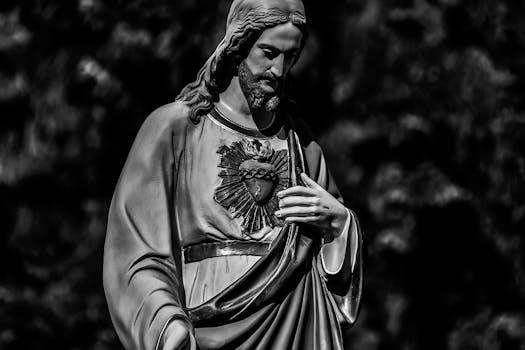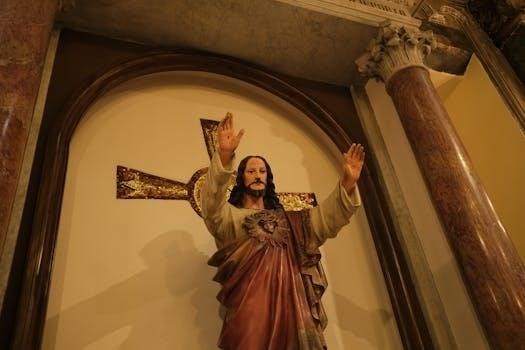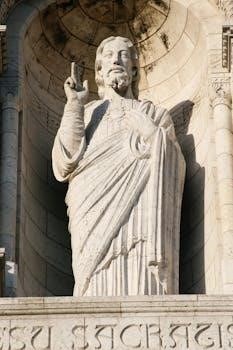The Litany of the Sacred Heart of Jesus is a powerful prayer‚ deeply rooted in Catholic tradition‚ that invokes the merciful love of Christ. This litany‚ often recited during June‚ the month dedicated to the Sacred Heart‚ calls upon the divine heart‚ and it is a beautiful expression of faith and devotion. It serves as a means of seeking grace and reflecting on Christ’s boundless love.
Overview of the Litany
The Litany of the Sacred Heart of Jesus is a structured prayer composed of a series of invocations and responses‚ designed to deepen one’s relationship with Christ’s love. The litany begins with the basic pleas of “Lord‚ have mercy‚” and “Christ‚ have mercy‚” then proceeds to address God the Father‚ God the Son‚ and God the Holy Spirit‚ as well as the Holy Trinity. Following this are specific invocations to the Heart of Jesus‚ using various titles and attributes that highlight the significance of Christ’s sacred heart. This repetition allows for contemplation on each aspect of Christ’s love and mercy. The structure facilitates a meditative and prayerful experience‚ drawing the faithful closer to the divine heart. The litany is a combination of different elements‚ creating a comprehensive prayer. It is a powerful way to express faith.

Core Elements of the Litany
The Litany of the Sacred Heart is built upon core invocations that seek divine mercy and acknowledge the Holy Trinity. These elements form the foundation of the prayer.
Invocation⁚ Lord‚ Have Mercy
The prayer begins with the repeated plea‚ “Lord‚ have mercy on us‚” a humble cry for divine compassion. This initial invocation sets the tone for the entire litany‚ emphasizing our dependence on God’s mercy. The phrase is a recognition of our human frailty and our need for forgiveness and grace. It is a fundamental expression of Christian humility‚ acknowledging that we are sinners who seek redemption through divine love. It is a call for the Lord to turn his gaze upon us with favor‚ to be touched by our sorrow‚ and to grant us the healing and solace we desperately seek. This supplication prepares our hearts to receive the blessings and graces that follow in the litany‚ establishing a foundation of hope and trust in God’s infinite mercy. This opening sets a tone of reverence and dependence on the divine.
Christ‚ Have Mercy and Hear Us
Following the initial plea to the Lord‚ the litany then specifically implores‚ “Christ‚ have mercy on us‚” directly addressing the Son of God. This invocation highlights Jesus’ unique role as the mediator between God and humanity; This invocation is followed by “Christ‚ hear us‚” a request for Jesus to not only have mercy but to also listen to our prayers. It acknowledges Jesus’ attentiveness to the faithful‚ as well as His willingness to respond to our needs. This dual request emphasizes that Christ is both merciful and compassionate‚ actively engaging with our prayers and petitions. This combination of pleas encapsulates the Christian belief in Christ’s active participation in the lives of the believers‚ as both redeemer and compassionate listener. It is a heartfelt cry of faith in the Son of God.
God‚ the Father of Heaven‚ Have Mercy
The litany then moves to address the first person of the Holy Trinity‚ stating “God‚ the Father of Heaven‚ have mercy on us.” This invocation acknowledges God as the ultimate source of creation and the origin of all goodness. It recognizes God’s supreme authority and his paternal role in the lives of believers. The phrase “Father of Heaven” emphasizes God’s transcendence‚ yet also His closeness and loving concern for His creation. This plea for mercy is a recognition of humanity’s dependence on God’s grace and compassion. It also underscores the essential belief in the Father’s role in the plan of salvation and the need for His divine mercy; This is a foundational element in the litany‚ placing the supplication within the context of the Trinitarian God.

God‚ the Son‚ Redeemer of the World‚ Have Mercy
Following the invocation to the Father‚ the Litany of the Sacred Heart of Jesus turns to the second person of the Trinity‚ proclaiming‚ “God‚ the Son‚ Redeemer of the World‚ have mercy on us.” This pivotal phrase acknowledges Jesus Christ’s divine nature as the Son of God‚ while also highlighting His crucial role in humanity’s salvation. As the Redeemer of the world‚ Jesus offers forgiveness‚ healing‚ and reconciliation through His sacrifice. This invocation is a direct appeal to Christ’s compassion and His willingness to extend mercy to all who seek it. It’s a reminder of His earthly life‚ death‚ and resurrection‚ emphasizing the love that prompted His sacrifice. This heartfelt plea for mercy underscores the central Christian belief in Jesus as the savior of humankind and the source of eternal hope and redemption.
God‚ the Holy Ghost‚ Have Mercy
The Litany of the Sacred Heart of Jesus continues with the invocation‚ “God‚ the Holy Ghost‚ have mercy on us.” This plea acknowledges the third person of the Holy Trinity‚ the Holy Spirit‚ as a source of divine grace and mercy. The Holy Spirit‚ often depicted as the breath of God‚ is believed to inspire‚ guide‚ and sanctify believers. By imploring the Holy Ghost‚ we recognize the Spirit’s essential role in the life of the Church and the individual believer. This invocation highlights the Holy Spirit’s work in enabling us to understand God’s love and to live according to His will‚ fostering faith‚ hope‚ and charity in our hearts. It is a call for the Spirit’s transformative power to heal‚ strengthen‚ and guide us on our spiritual journeys‚ leading us closer to the Sacred Heart of Jesus.
Holy Trinity‚ One God‚ Have Mercy
Following the individual invocations to God the Father‚ God the Son‚ and God the Holy Ghost‚ the Litany of the Sacred Heart of Jesus unites these three divine persons into one unified plea⁚ “Holy Trinity‚ One God‚ have mercy on us.” This invocation encapsulates the core Christian belief in the Trinity—three distinct persons in one Godhead. It is a powerful declaration of faith‚ recognizing the unity and equality of the Father‚ Son‚ and Holy Spirit‚ while acknowledging their distinct roles in salvation history. By appealing to the Holy Trinity as one God‚ we are asking for the combined mercy‚ love‚ and grace of the entire Godhead to be bestowed upon us. This plea underscores the foundational Christian doctrine and the divine mystery of the Triune God‚ highlighting the interconnectedness of the divine persons in their salvific work and their boundless love for humanity.

Specific Invocations to the Heart of Jesus
The litany then transitions to specific invocations‚ directly addressing the Heart of Jesus. These particular calls focus on various aspects of His sacred heart‚ such as its divine origin and formation.
Heart of Jesus‚ Son of the Eternal Father
This invocation within the Litany of the Sacred Heart of Jesus highlights the divine nature of Christ‚ emphasizing His eternal relationship with God the Father. It acknowledges that Jesus‚ whose heart is the focal point of this devotion‚ is not merely a historical figure but is the Son of the Eternal Father‚ co-equal with Him in divinity. This phrase underscores the profound theological truth of the Incarnation‚ the mystery of God becoming man. When we repeat these words‚ “Heart of Jesus‚ Son of the Eternal Father‚ have mercy on us‚” we are appealing to the very core of God’s love‚ manifested in the person of Jesus. It is a powerful affirmation of faith and a plea for divine mercy‚ recognizing the inseparable link between the Son and the Father. The invocation serves as a constant reminder of the eternal nature of God’s love for humanity through His Son. This acknowledgment is pivotal‚ setting the stage for the litany’s subsequent praises and supplications‚ all directed to the Sacred Heart.
Heart of Jesus‚ Formed by the Holy Spirit
This particular invocation in the Litany of the Sacred Heart of Jesus speaks to the miraculous conception of Jesus‚ emphasizing the role of the Holy Spirit in His human formation. It acknowledges that Jesus’ heart‚ the very essence of His divine-human nature‚ was formed not through ordinary human means but by the power of the Holy Spirit in the womb of the Virgin Mary. This phrase highlights the unique and sacred beginning of Jesus’ life‚ underlining the mystery of the Incarnation. When we say‚ “Heart of Jesus‚ formed by the Holy Spirit in the womb of the Virgin Mother‚ have mercy on us‚” we are recognizing the divine intervention that brought about the Savior. This is a powerful reminder of the Spirit’s role in the plan of salvation and the profound holiness inherent in Jesus’ being from the moment of conception‚ making the heart of Jesus a vessel of divine love and grace. The Holy Spirit’s contribution underscores the divine origin of Christ’s earthly life and the depth of God’s love for humanity.

Historical Context and Significance
The Litany‚ with roots in Marseilles‚ gained formal approval for public recitation in 1899. It combines elements from earlier litanies‚ reflecting a long-standing devotion to the Sacred Heart and its significance.
Origin of the Litany and Approval for Public Use
The Litany of the Sacred Heart of Jesus‚ as it is known today‚ is not a single‚ original composition but rather a synthesis of earlier devotional texts. Its origins can be traced back to Marseilles‚ where a strong devotion to the Sacred Heart of Jesus had taken root. This particular devotion‚ focused on the love and compassion symbolized by Christ’s heart‚ inspired the creation of various litanies and prayers over time. The litany as we know it today is a combination of these earlier forms‚ refined and structured into a more cohesive devotional prayer. It is important to note that the public recitation of this litany was officially approved in 1899‚ marking a significant milestone in its history. This approval recognized its theological soundness and its value in fostering devotion to the Sacred Heart among the faithful. The formal sanction by the Church also facilitated the wider adoption and use of the litany in both public and private prayer practices‚ solidifying its place in Catholic tradition. The blending of various sources into this single litany resulted in a beautiful and theologically rich prayer.
